Major Essay: The Role of Leaders in Implementing Changes in Healthcare
VerifiedAdded on 2023/06/11
|14
|4134
|183
Essay
AI Summary
This essay critically discusses the role of leadership in facilitating and achieving desired changes in healthcare organizations. It examines the importance of leadership styles, such as contingency, situational, and interaction theories, in driving change. The essay also highlights the steps for implementing changes, including Lewin's three-stage model (unfreezing, moving, and freezing), and emphasizes the significance of workplace culture in either enhancing or hindering the change process. It underscores the need for leaders to motivate, communicate, and manage transitions effectively to foster a positive and adaptive organizational environment that supports performance improvement and quality service delivery.
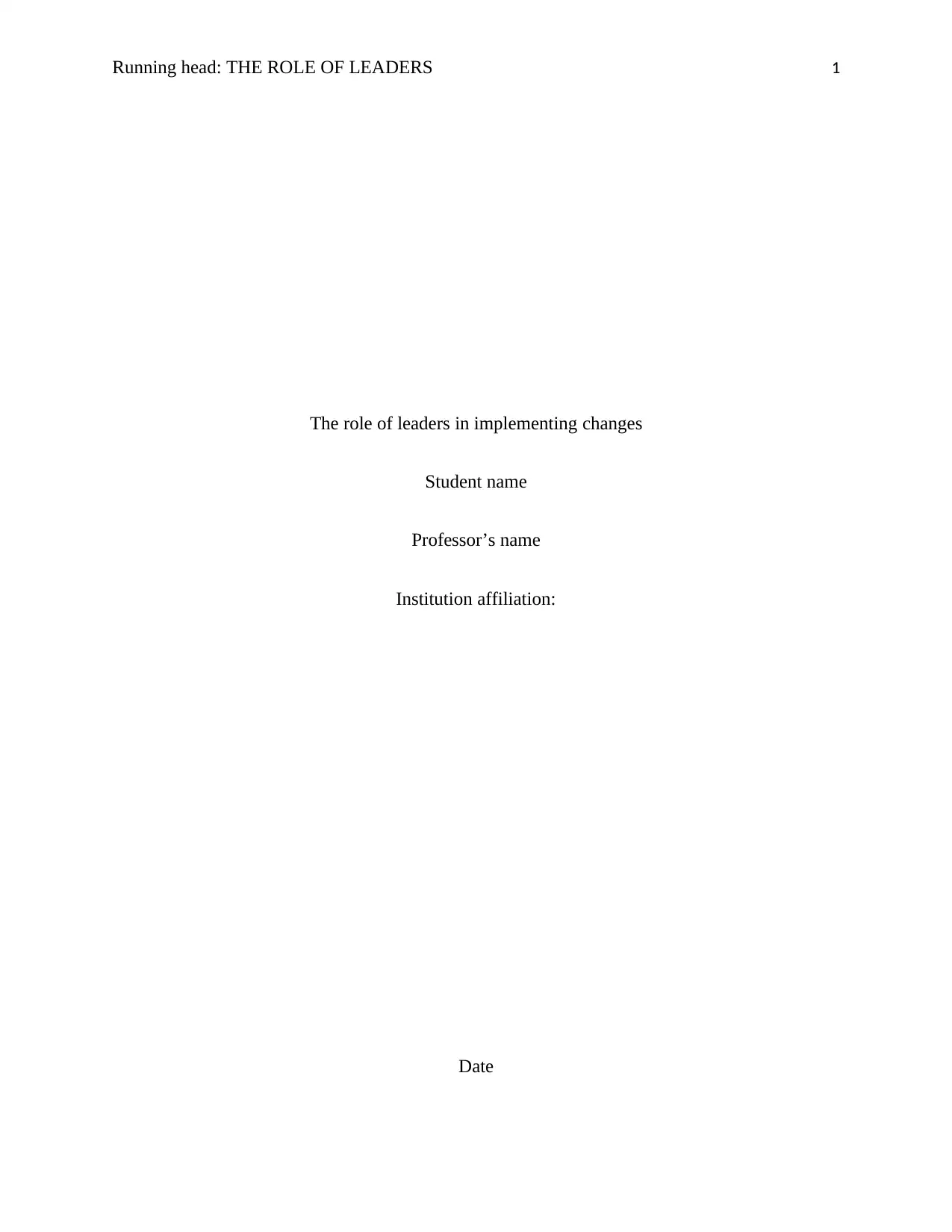
Running head: THE ROLE OF LEADERS 1
The role of leaders in implementing changes
Student name
Professor’s name
Institution affiliation:
Date
The role of leaders in implementing changes
Student name
Professor’s name
Institution affiliation:
Date
Paraphrase This Document
Need a fresh take? Get an instant paraphrase of this document with our AI Paraphraser
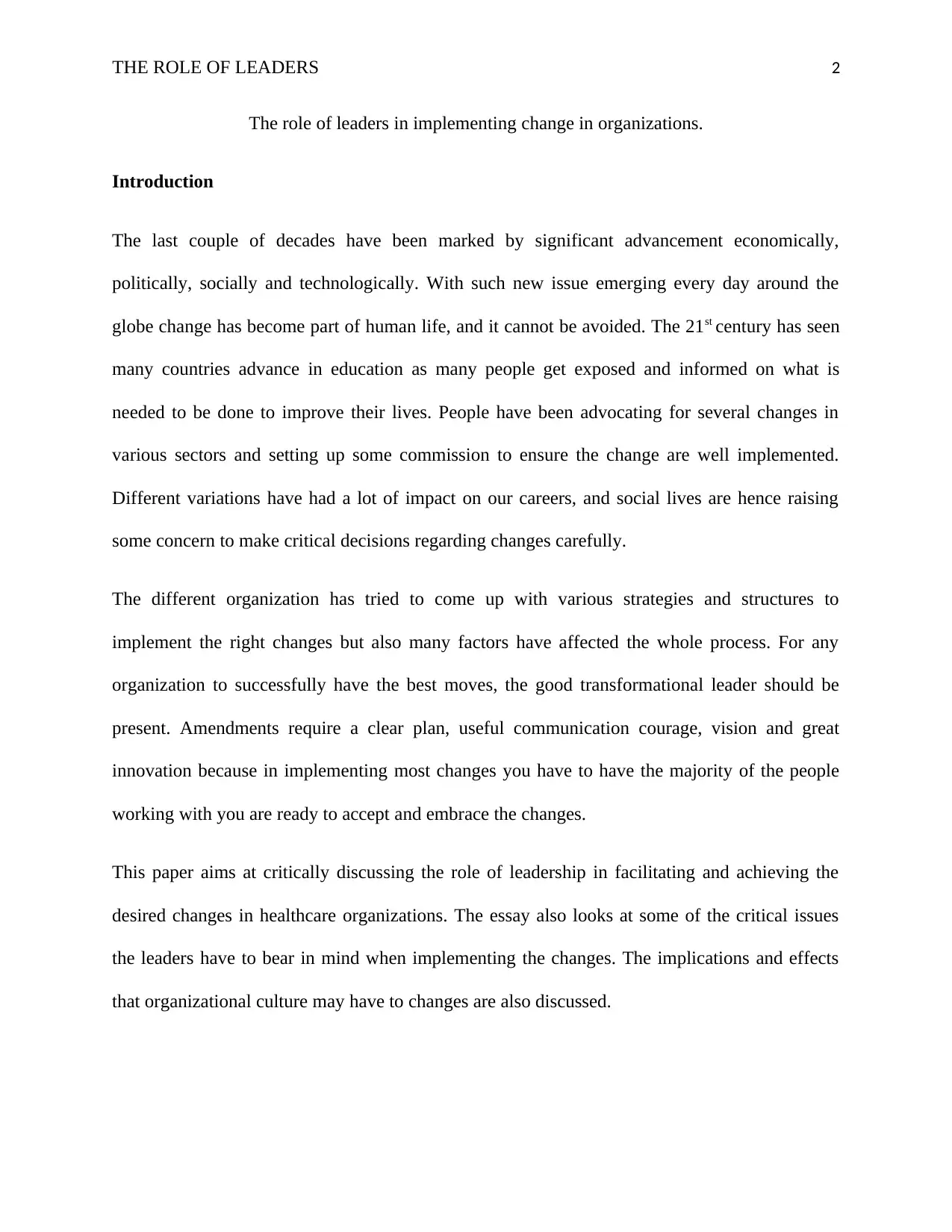
THE ROLE OF LEADERS 2
The role of leaders in implementing change in organizations.
Introduction
The last couple of decades have been marked by significant advancement economically,
politically, socially and technologically. With such new issue emerging every day around the
globe change has become part of human life, and it cannot be avoided. The 21st century has seen
many countries advance in education as many people get exposed and informed on what is
needed to be done to improve their lives. People have been advocating for several changes in
various sectors and setting up some commission to ensure the change are well implemented.
Different variations have had a lot of impact on our careers, and social lives are hence raising
some concern to make critical decisions regarding changes carefully.
The different organization has tried to come up with various strategies and structures to
implement the right changes but also many factors have affected the whole process. For any
organization to successfully have the best moves, the good transformational leader should be
present. Amendments require a clear plan, useful communication courage, vision and great
innovation because in implementing most changes you have to have the majority of the people
working with you are ready to accept and embrace the changes.
This paper aims at critically discussing the role of leadership in facilitating and achieving the
desired changes in healthcare organizations. The essay also looks at some of the critical issues
the leaders have to bear in mind when implementing the changes. The implications and effects
that organizational culture may have to changes are also discussed.
The role of leaders in implementing change in organizations.
Introduction
The last couple of decades have been marked by significant advancement economically,
politically, socially and technologically. With such new issue emerging every day around the
globe change has become part of human life, and it cannot be avoided. The 21st century has seen
many countries advance in education as many people get exposed and informed on what is
needed to be done to improve their lives. People have been advocating for several changes in
various sectors and setting up some commission to ensure the change are well implemented.
Different variations have had a lot of impact on our careers, and social lives are hence raising
some concern to make critical decisions regarding changes carefully.
The different organization has tried to come up with various strategies and structures to
implement the right changes but also many factors have affected the whole process. For any
organization to successfully have the best moves, the good transformational leader should be
present. Amendments require a clear plan, useful communication courage, vision and great
innovation because in implementing most changes you have to have the majority of the people
working with you are ready to accept and embrace the changes.
This paper aims at critically discussing the role of leadership in facilitating and achieving the
desired changes in healthcare organizations. The essay also looks at some of the critical issues
the leaders have to bear in mind when implementing the changes. The implications and effects
that organizational culture may have to changes are also discussed.
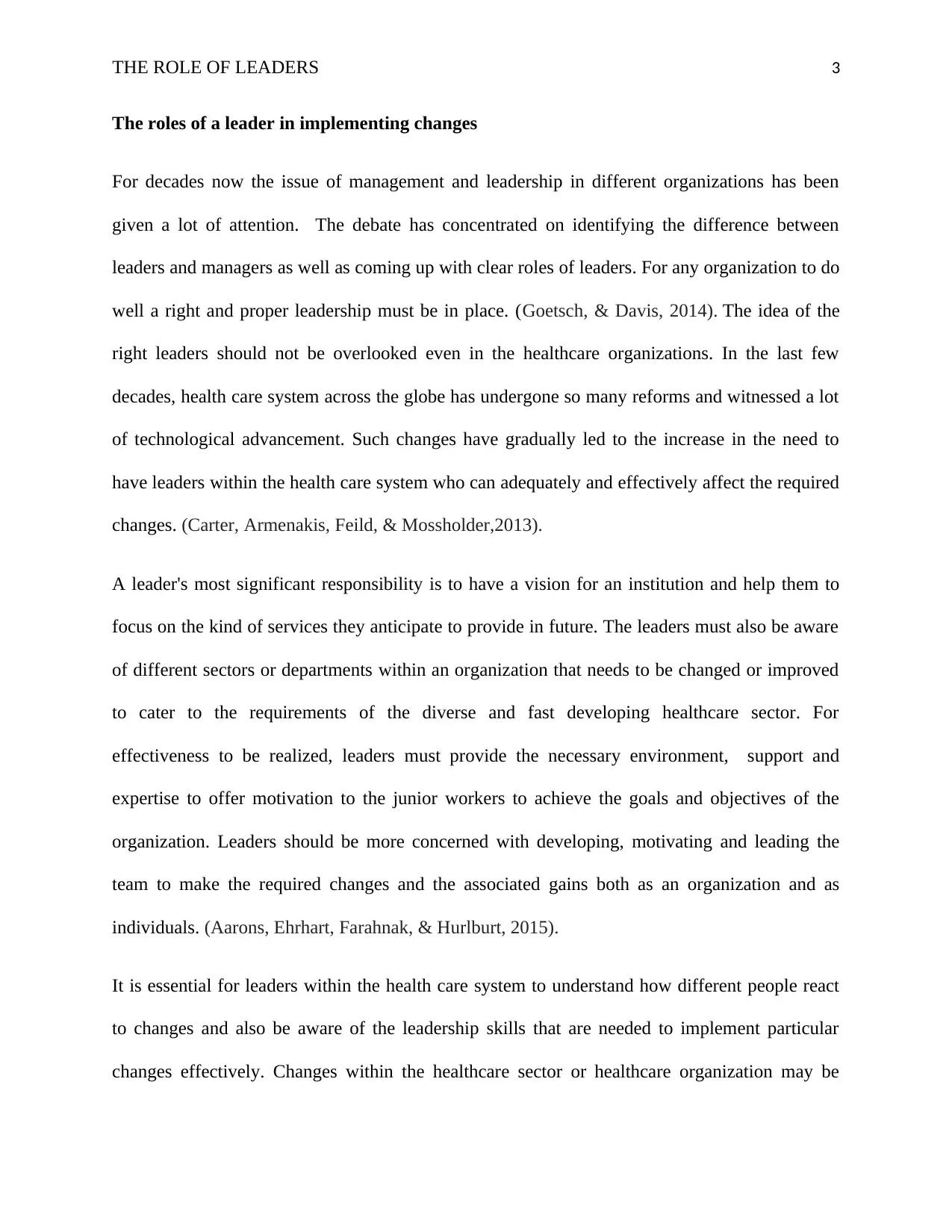
THE ROLE OF LEADERS 3
The roles of a leader in implementing changes
For decades now the issue of management and leadership in different organizations has been
given a lot of attention. The debate has concentrated on identifying the difference between
leaders and managers as well as coming up with clear roles of leaders. For any organization to do
well a right and proper leadership must be in place. (Goetsch, & Davis, 2014). The idea of the
right leaders should not be overlooked even in the healthcare organizations. In the last few
decades, health care system across the globe has undergone so many reforms and witnessed a lot
of technological advancement. Such changes have gradually led to the increase in the need to
have leaders within the health care system who can adequately and effectively affect the required
changes. (Carter, Armenakis, Feild, & Mossholder,2013).
A leader's most significant responsibility is to have a vision for an institution and help them to
focus on the kind of services they anticipate to provide in future. The leaders must also be aware
of different sectors or departments within an organization that needs to be changed or improved
to cater to the requirements of the diverse and fast developing healthcare sector. For
effectiveness to be realized, leaders must provide the necessary environment, support and
expertise to offer motivation to the junior workers to achieve the goals and objectives of the
organization. Leaders should be more concerned with developing, motivating and leading the
team to make the required changes and the associated gains both as an organization and as
individuals. (Aarons, Ehrhart, Farahnak, & Hurlburt, 2015).
It is essential for leaders within the health care system to understand how different people react
to changes and also be aware of the leadership skills that are needed to implement particular
changes effectively. Changes within the healthcare sector or healthcare organization may be
The roles of a leader in implementing changes
For decades now the issue of management and leadership in different organizations has been
given a lot of attention. The debate has concentrated on identifying the difference between
leaders and managers as well as coming up with clear roles of leaders. For any organization to do
well a right and proper leadership must be in place. (Goetsch, & Davis, 2014). The idea of the
right leaders should not be overlooked even in the healthcare organizations. In the last few
decades, health care system across the globe has undergone so many reforms and witnessed a lot
of technological advancement. Such changes have gradually led to the increase in the need to
have leaders within the health care system who can adequately and effectively affect the required
changes. (Carter, Armenakis, Feild, & Mossholder,2013).
A leader's most significant responsibility is to have a vision for an institution and help them to
focus on the kind of services they anticipate to provide in future. The leaders must also be aware
of different sectors or departments within an organization that needs to be changed or improved
to cater to the requirements of the diverse and fast developing healthcare sector. For
effectiveness to be realized, leaders must provide the necessary environment, support and
expertise to offer motivation to the junior workers to achieve the goals and objectives of the
organization. Leaders should be more concerned with developing, motivating and leading the
team to make the required changes and the associated gains both as an organization and as
individuals. (Aarons, Ehrhart, Farahnak, & Hurlburt, 2015).
It is essential for leaders within the health care system to understand how different people react
to changes and also be aware of the leadership skills that are needed to implement particular
changes effectively. Changes within the healthcare sector or healthcare organization may be
⊘ This is a preview!⊘
Do you want full access?
Subscribe today to unlock all pages.

Trusted by 1+ million students worldwide

THE ROLE OF LEADERS 4
required at different levels depending on the problem identified and what the management
wishes to achieve within a given timeframe. In case people do not see the positive results or
benefits of the proposed changes to either themselves or the organization, they are likely to get
bored and lose the moral to continue implementing the changes. Any time a leader thinks of
achieving a difference, he or she should consider the purpose of the changes and the possible
responses from the people who will be involved or affected by the changes in one way or the
other. (McCormack et al. 2013)
Leadership styles
Some leadership styles evolved and developed over time in the process of seeking to provide the
best in any organization. Changes in health organizations can be affected by two main theories.
I.e., contingency and situational leadership theories and the interaction theories of leadership.
(Mitchell, 2013).
Contingency and leadership theory is a leadership theory aimed at assessing the situation in a
workplace, how complicated the workplace is and the relationship between the leader and the
rest of the team instead of entirely focusing on the behaviors and traits of the leaders. The theory
suggests that there is no one specific leadership style fit for every job, work team or situation,
therefore, any good leader should be able to adopt and use a variety of styles depending upon
the skills, relationship, type of work and the level of education of the people in a particular job
or situation. The theory transfers the attention from the traits or characteristics of an individual to
the importance of having mature participants and the commitment of all the parties involved.
The approach also holds that a leader may be forced to act autocratically and give directions on
what to do in case there is an emergency (Chemers, 2014).
required at different levels depending on the problem identified and what the management
wishes to achieve within a given timeframe. In case people do not see the positive results or
benefits of the proposed changes to either themselves or the organization, they are likely to get
bored and lose the moral to continue implementing the changes. Any time a leader thinks of
achieving a difference, he or she should consider the purpose of the changes and the possible
responses from the people who will be involved or affected by the changes in one way or the
other. (McCormack et al. 2013)
Leadership styles
Some leadership styles evolved and developed over time in the process of seeking to provide the
best in any organization. Changes in health organizations can be affected by two main theories.
I.e., contingency and situational leadership theories and the interaction theories of leadership.
(Mitchell, 2013).
Contingency and leadership theory is a leadership theory aimed at assessing the situation in a
workplace, how complicated the workplace is and the relationship between the leader and the
rest of the team instead of entirely focusing on the behaviors and traits of the leaders. The theory
suggests that there is no one specific leadership style fit for every job, work team or situation,
therefore, any good leader should be able to adopt and use a variety of styles depending upon
the skills, relationship, type of work and the level of education of the people in a particular job
or situation. The theory transfers the attention from the traits or characteristics of an individual to
the importance of having mature participants and the commitment of all the parties involved.
The approach also holds that a leader may be forced to act autocratically and give directions on
what to do in case there is an emergency (Chemers, 2014).
Paraphrase This Document
Need a fresh take? Get an instant paraphrase of this document with our AI Paraphraser
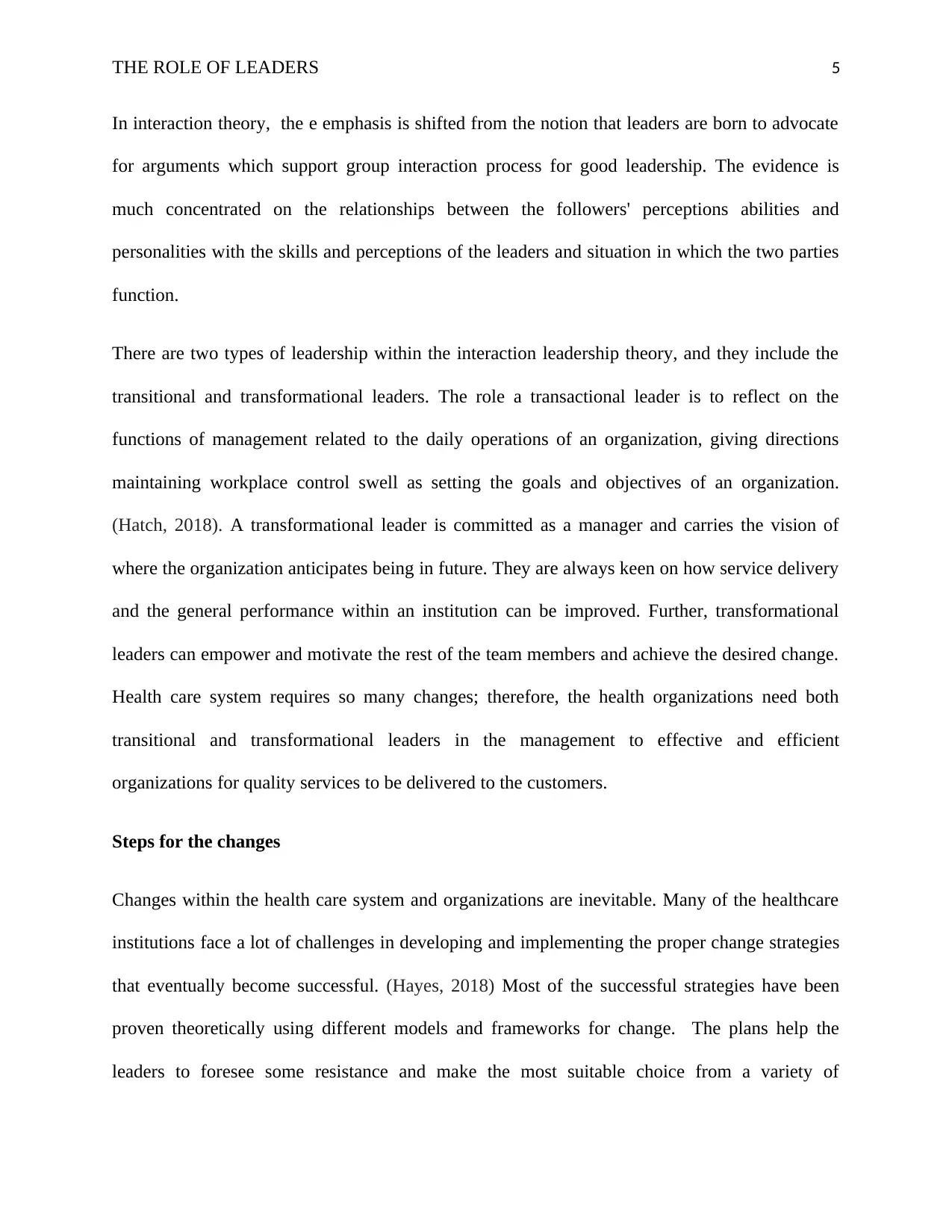
THE ROLE OF LEADERS 5
In interaction theory, the e emphasis is shifted from the notion that leaders are born to advocate
for arguments which support group interaction process for good leadership. The evidence is
much concentrated on the relationships between the followers' perceptions abilities and
personalities with the skills and perceptions of the leaders and situation in which the two parties
function.
There are two types of leadership within the interaction leadership theory, and they include the
transitional and transformational leaders. The role a transactional leader is to reflect on the
functions of management related to the daily operations of an organization, giving directions
maintaining workplace control swell as setting the goals and objectives of an organization.
(Hatch, 2018). A transformational leader is committed as a manager and carries the vision of
where the organization anticipates being in future. They are always keen on how service delivery
and the general performance within an institution can be improved. Further, transformational
leaders can empower and motivate the rest of the team members and achieve the desired change.
Health care system requires so many changes; therefore, the health organizations need both
transitional and transformational leaders in the management to effective and efficient
organizations for quality services to be delivered to the customers.
Steps for the changes
Changes within the health care system and organizations are inevitable. Many of the healthcare
institutions face a lot of challenges in developing and implementing the proper change strategies
that eventually become successful. (Hayes, 2018) Most of the successful strategies have been
proven theoretically using different models and frameworks for change. The plans help the
leaders to foresee some resistance and make the most suitable choice from a variety of
In interaction theory, the e emphasis is shifted from the notion that leaders are born to advocate
for arguments which support group interaction process for good leadership. The evidence is
much concentrated on the relationships between the followers' perceptions abilities and
personalities with the skills and perceptions of the leaders and situation in which the two parties
function.
There are two types of leadership within the interaction leadership theory, and they include the
transitional and transformational leaders. The role a transactional leader is to reflect on the
functions of management related to the daily operations of an organization, giving directions
maintaining workplace control swell as setting the goals and objectives of an organization.
(Hatch, 2018). A transformational leader is committed as a manager and carries the vision of
where the organization anticipates being in future. They are always keen on how service delivery
and the general performance within an institution can be improved. Further, transformational
leaders can empower and motivate the rest of the team members and achieve the desired change.
Health care system requires so many changes; therefore, the health organizations need both
transitional and transformational leaders in the management to effective and efficient
organizations for quality services to be delivered to the customers.
Steps for the changes
Changes within the health care system and organizations are inevitable. Many of the healthcare
institutions face a lot of challenges in developing and implementing the proper change strategies
that eventually become successful. (Hayes, 2018) Most of the successful strategies have been
proven theoretically using different models and frameworks for change. The plans help the
leaders to foresee some resistance and make the most suitable choice from a variety of
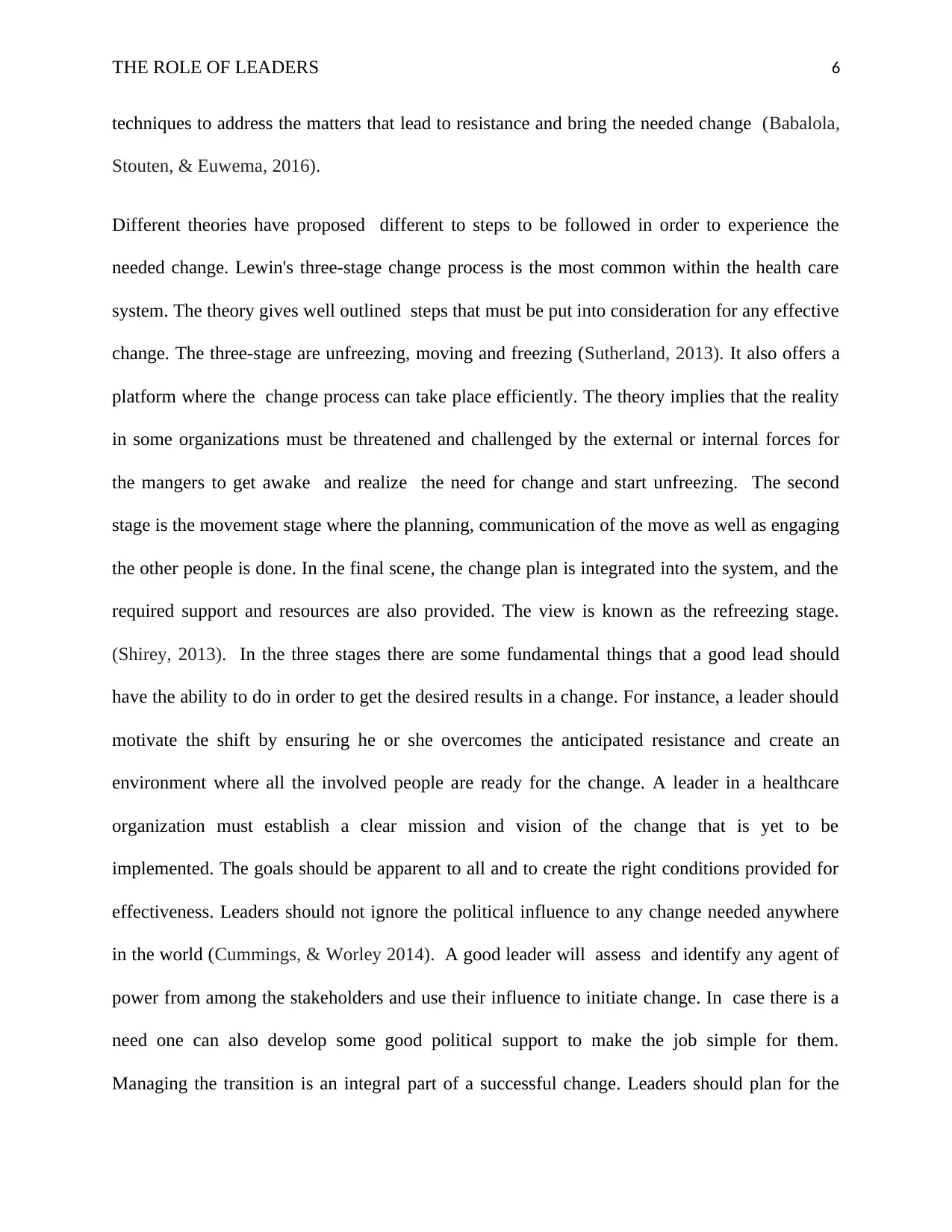
THE ROLE OF LEADERS 6
techniques to address the matters that lead to resistance and bring the needed change (Babalola,
Stouten, & Euwema, 2016).
Different theories have proposed different to steps to be followed in order to experience the
needed change. Lewin's three-stage change process is the most common within the health care
system. The theory gives well outlined steps that must be put into consideration for any effective
change. The three-stage are unfreezing, moving and freezing (Sutherland, 2013). It also offers a
platform where the change process can take place efficiently. The theory implies that the reality
in some organizations must be threatened and challenged by the external or internal forces for
the mangers to get awake and realize the need for change and start unfreezing. The second
stage is the movement stage where the planning, communication of the move as well as engaging
the other people is done. In the final scene, the change plan is integrated into the system, and the
required support and resources are also provided. The view is known as the refreezing stage.
(Shirey, 2013). In the three stages there are some fundamental things that a good lead should
have the ability to do in order to get the desired results in a change. For instance, a leader should
motivate the shift by ensuring he or she overcomes the anticipated resistance and create an
environment where all the involved people are ready for the change. A leader in a healthcare
organization must establish a clear mission and vision of the change that is yet to be
implemented. The goals should be apparent to all and to create the right conditions provided for
effectiveness. Leaders should not ignore the political influence to any change needed anywhere
in the world (Cummings, & Worley 2014). A good leader will assess and identify any agent of
power from among the stakeholders and use their influence to initiate change. In case there is a
need one can also develop some good political support to make the job simple for them.
Managing the transition is an integral part of a successful change. Leaders should plan for the
techniques to address the matters that lead to resistance and bring the needed change (Babalola,
Stouten, & Euwema, 2016).
Different theories have proposed different to steps to be followed in order to experience the
needed change. Lewin's three-stage change process is the most common within the health care
system. The theory gives well outlined steps that must be put into consideration for any effective
change. The three-stage are unfreezing, moving and freezing (Sutherland, 2013). It also offers a
platform where the change process can take place efficiently. The theory implies that the reality
in some organizations must be threatened and challenged by the external or internal forces for
the mangers to get awake and realize the need for change and start unfreezing. The second
stage is the movement stage where the planning, communication of the move as well as engaging
the other people is done. In the final scene, the change plan is integrated into the system, and the
required support and resources are also provided. The view is known as the refreezing stage.
(Shirey, 2013). In the three stages there are some fundamental things that a good lead should
have the ability to do in order to get the desired results in a change. For instance, a leader should
motivate the shift by ensuring he or she overcomes the anticipated resistance and create an
environment where all the involved people are ready for the change. A leader in a healthcare
organization must establish a clear mission and vision of the change that is yet to be
implemented. The goals should be apparent to all and to create the right conditions provided for
effectiveness. Leaders should not ignore the political influence to any change needed anywhere
in the world (Cummings, & Worley 2014). A good leader will assess and identify any agent of
power from among the stakeholders and use their influence to initiate change. In case there is a
need one can also develop some good political support to make the job simple for them.
Managing the transition is an integral part of a successful change. Leaders should plan for the
⊘ This is a preview!⊘
Do you want full access?
Subscribe today to unlock all pages.

Trusted by 1+ million students worldwide
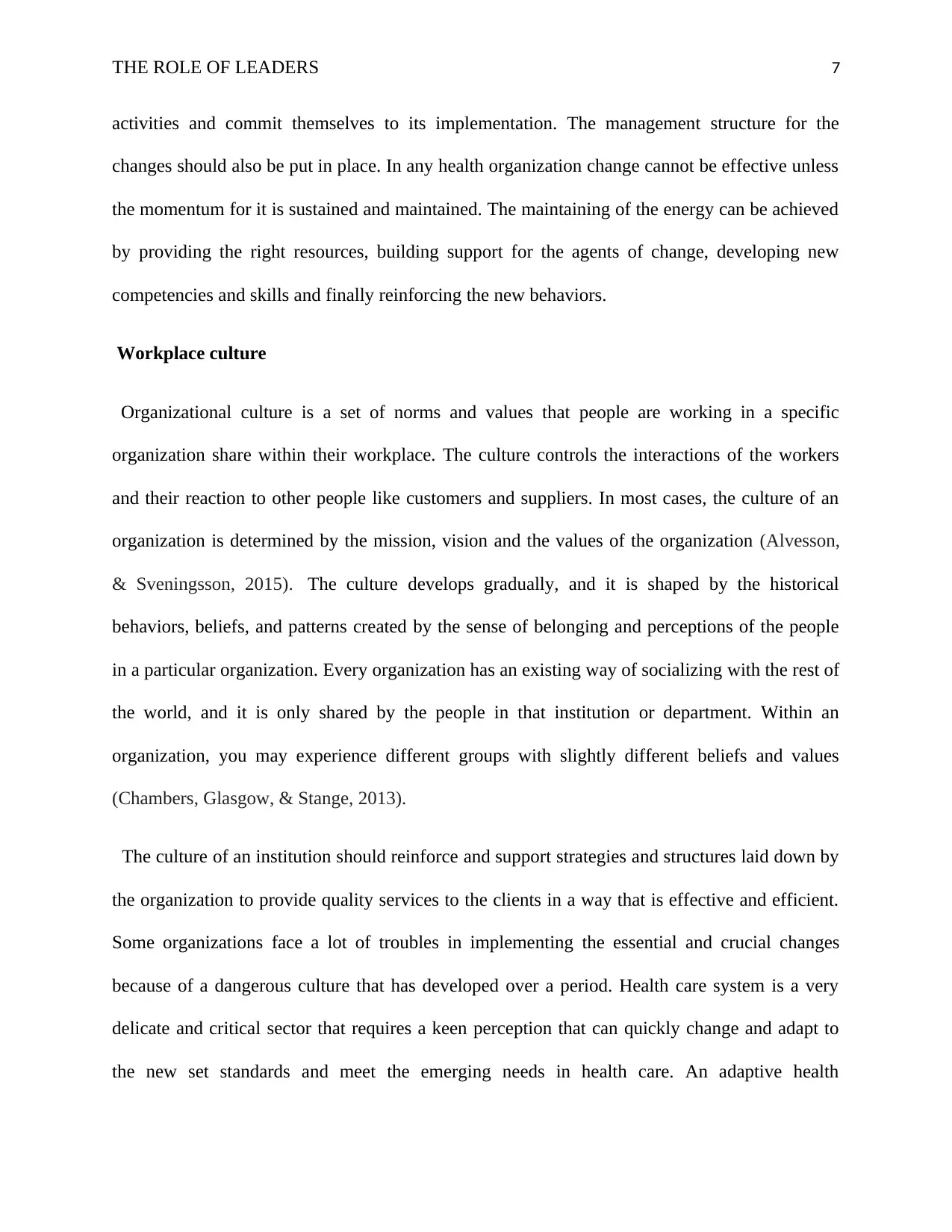
THE ROLE OF LEADERS 7
activities and commit themselves to its implementation. The management structure for the
changes should also be put in place. In any health organization change cannot be effective unless
the momentum for it is sustained and maintained. The maintaining of the energy can be achieved
by providing the right resources, building support for the agents of change, developing new
competencies and skills and finally reinforcing the new behaviors.
Workplace culture
Organizational culture is a set of norms and values that people are working in a specific
organization share within their workplace. The culture controls the interactions of the workers
and their reaction to other people like customers and suppliers. In most cases, the culture of an
organization is determined by the mission, vision and the values of the organization (Alvesson,
& Sveningsson, 2015). The culture develops gradually, and it is shaped by the historical
behaviors, beliefs, and patterns created by the sense of belonging and perceptions of the people
in a particular organization. Every organization has an existing way of socializing with the rest of
the world, and it is only shared by the people in that institution or department. Within an
organization, you may experience different groups with slightly different beliefs and values
(Chambers, Glasgow, & Stange, 2013).
The culture of an institution should reinforce and support strategies and structures laid down by
the organization to provide quality services to the clients in a way that is effective and efficient.
Some organizations face a lot of troubles in implementing the essential and crucial changes
because of a dangerous culture that has developed over a period. Health care system is a very
delicate and critical sector that requires a keen perception that can quickly change and adapt to
the new set standards and meet the emerging needs in health care. An adaptive health
activities and commit themselves to its implementation. The management structure for the
changes should also be put in place. In any health organization change cannot be effective unless
the momentum for it is sustained and maintained. The maintaining of the energy can be achieved
by providing the right resources, building support for the agents of change, developing new
competencies and skills and finally reinforcing the new behaviors.
Workplace culture
Organizational culture is a set of norms and values that people are working in a specific
organization share within their workplace. The culture controls the interactions of the workers
and their reaction to other people like customers and suppliers. In most cases, the culture of an
organization is determined by the mission, vision and the values of the organization (Alvesson,
& Sveningsson, 2015). The culture develops gradually, and it is shaped by the historical
behaviors, beliefs, and patterns created by the sense of belonging and perceptions of the people
in a particular organization. Every organization has an existing way of socializing with the rest of
the world, and it is only shared by the people in that institution or department. Within an
organization, you may experience different groups with slightly different beliefs and values
(Chambers, Glasgow, & Stange, 2013).
The culture of an institution should reinforce and support strategies and structures laid down by
the organization to provide quality services to the clients in a way that is effective and efficient.
Some organizations face a lot of troubles in implementing the essential and crucial changes
because of a dangerous culture that has developed over a period. Health care system is a very
delicate and critical sector that requires a keen perception that can quickly change and adapt to
the new set standards and meet the emerging needs in health care. An adaptive health
Paraphrase This Document
Need a fresh take? Get an instant paraphrase of this document with our AI Paraphraser
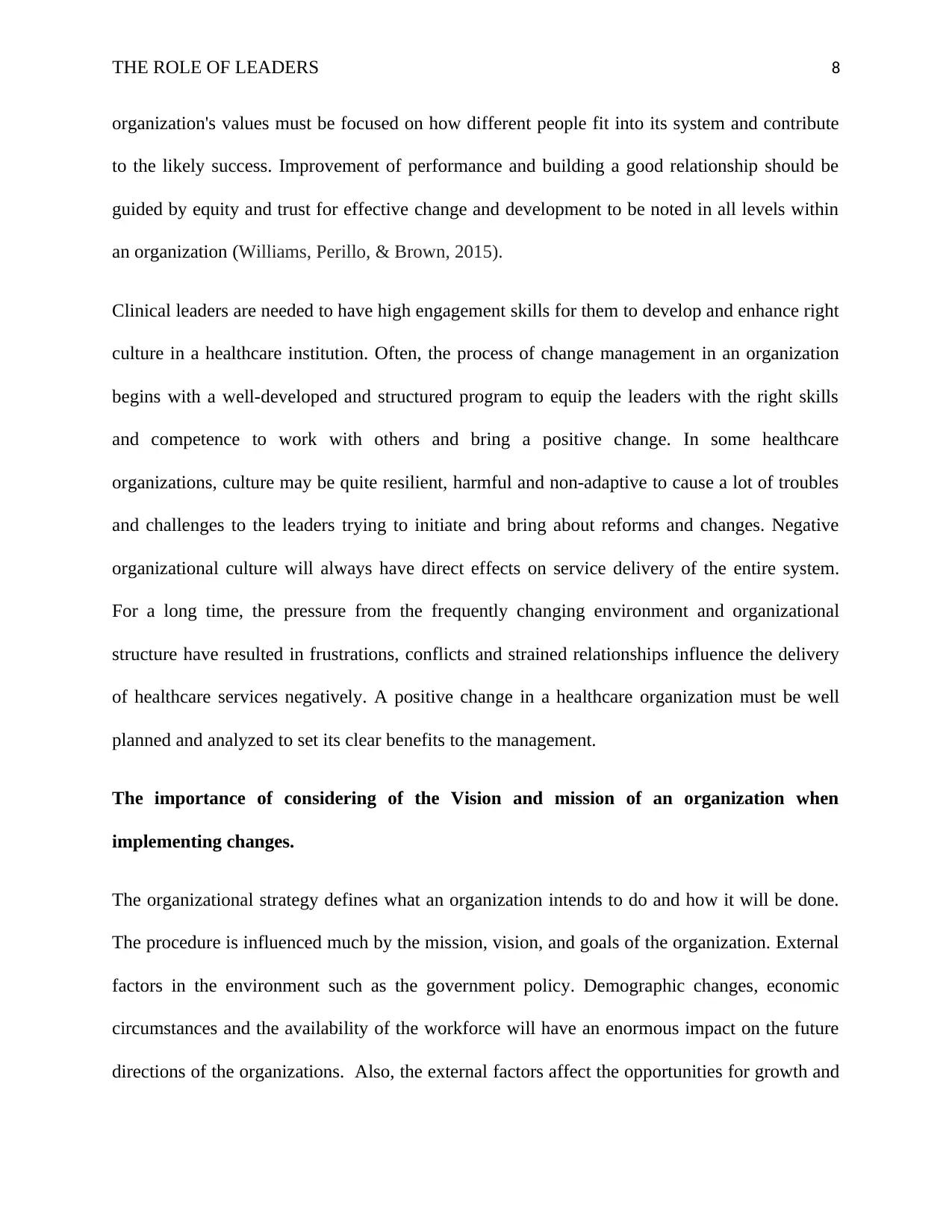
THE ROLE OF LEADERS 8
organization's values must be focused on how different people fit into its system and contribute
to the likely success. Improvement of performance and building a good relationship should be
guided by equity and trust for effective change and development to be noted in all levels within
an organization (Williams, Perillo, & Brown, 2015).
Clinical leaders are needed to have high engagement skills for them to develop and enhance right
culture in a healthcare institution. Often, the process of change management in an organization
begins with a well-developed and structured program to equip the leaders with the right skills
and competence to work with others and bring a positive change. In some healthcare
organizations, culture may be quite resilient, harmful and non-adaptive to cause a lot of troubles
and challenges to the leaders trying to initiate and bring about reforms and changes. Negative
organizational culture will always have direct effects on service delivery of the entire system.
For a long time, the pressure from the frequently changing environment and organizational
structure have resulted in frustrations, conflicts and strained relationships influence the delivery
of healthcare services negatively. A positive change in a healthcare organization must be well
planned and analyzed to set its clear benefits to the management.
The importance of considering of the Vision and mission of an organization when
implementing changes.
The organizational strategy defines what an organization intends to do and how it will be done.
The procedure is influenced much by the mission, vision, and goals of the organization. External
factors in the environment such as the government policy. Demographic changes, economic
circumstances and the availability of the workforce will have an enormous impact on the future
directions of the organizations. Also, the external factors affect the opportunities for growth and
organization's values must be focused on how different people fit into its system and contribute
to the likely success. Improvement of performance and building a good relationship should be
guided by equity and trust for effective change and development to be noted in all levels within
an organization (Williams, Perillo, & Brown, 2015).
Clinical leaders are needed to have high engagement skills for them to develop and enhance right
culture in a healthcare institution. Often, the process of change management in an organization
begins with a well-developed and structured program to equip the leaders with the right skills
and competence to work with others and bring a positive change. In some healthcare
organizations, culture may be quite resilient, harmful and non-adaptive to cause a lot of troubles
and challenges to the leaders trying to initiate and bring about reforms and changes. Negative
organizational culture will always have direct effects on service delivery of the entire system.
For a long time, the pressure from the frequently changing environment and organizational
structure have resulted in frustrations, conflicts and strained relationships influence the delivery
of healthcare services negatively. A positive change in a healthcare organization must be well
planned and analyzed to set its clear benefits to the management.
The importance of considering of the Vision and mission of an organization when
implementing changes.
The organizational strategy defines what an organization intends to do and how it will be done.
The procedure is influenced much by the mission, vision, and goals of the organization. External
factors in the environment such as the government policy. Demographic changes, economic
circumstances and the availability of the workforce will have an enormous impact on the future
directions of the organizations. Also, the external factors affect the opportunities for growth and
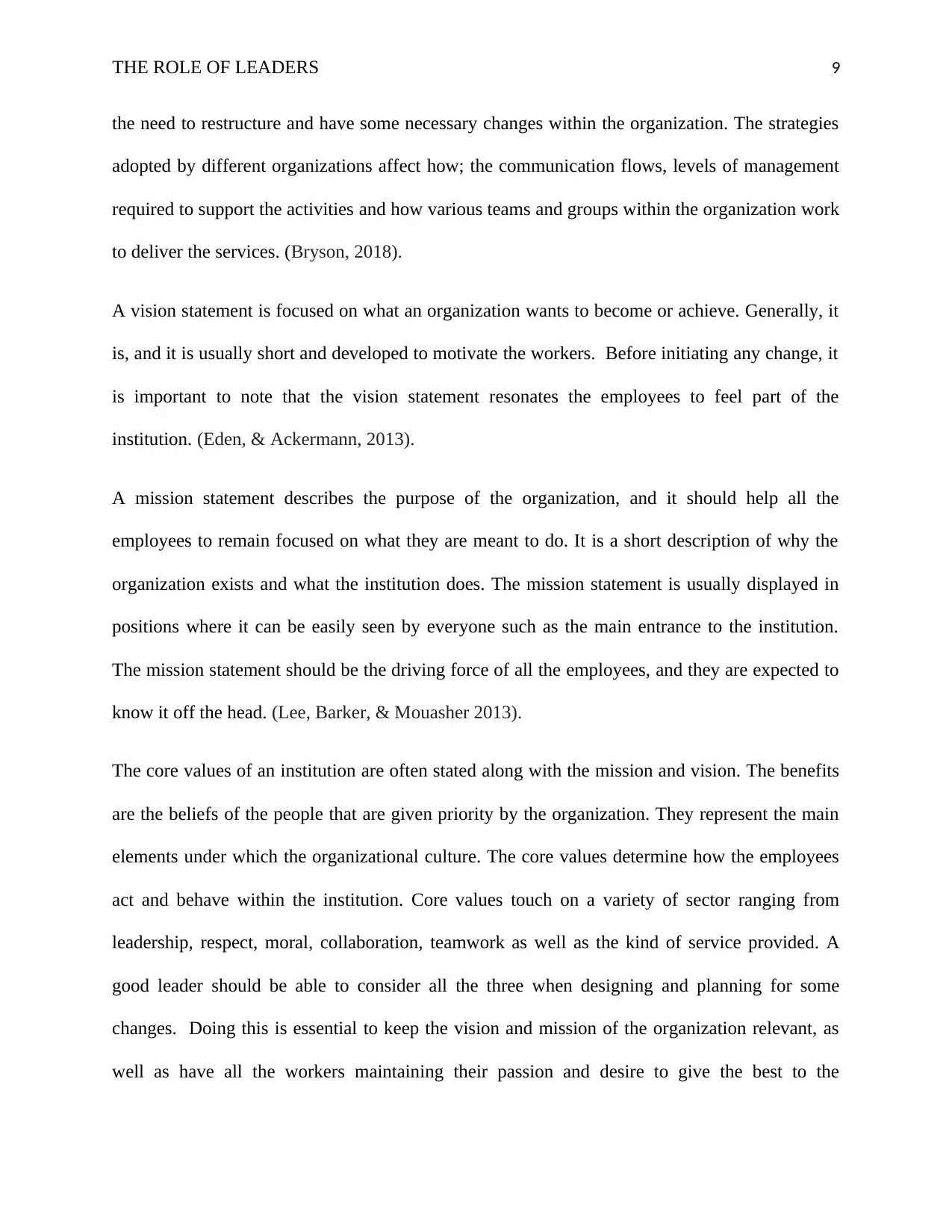
THE ROLE OF LEADERS 9
the need to restructure and have some necessary changes within the organization. The strategies
adopted by different organizations affect how; the communication flows, levels of management
required to support the activities and how various teams and groups within the organization work
to deliver the services. (Bryson, 2018).
A vision statement is focused on what an organization wants to become or achieve. Generally, it
is, and it is usually short and developed to motivate the workers. Before initiating any change, it
is important to note that the vision statement resonates the employees to feel part of the
institution. (Eden, & Ackermann, 2013).
A mission statement describes the purpose of the organization, and it should help all the
employees to remain focused on what they are meant to do. It is a short description of why the
organization exists and what the institution does. The mission statement is usually displayed in
positions where it can be easily seen by everyone such as the main entrance to the institution.
The mission statement should be the driving force of all the employees, and they are expected to
know it off the head. (Lee, Barker, & Mouasher 2013).
The core values of an institution are often stated along with the mission and vision. The benefits
are the beliefs of the people that are given priority by the organization. They represent the main
elements under which the organizational culture. The core values determine how the employees
act and behave within the institution. Core values touch on a variety of sector ranging from
leadership, respect, moral, collaboration, teamwork as well as the kind of service provided. A
good leader should be able to consider all the three when designing and planning for some
changes. Doing this is essential to keep the vision and mission of the organization relevant, as
well as have all the workers maintaining their passion and desire to give the best to the
the need to restructure and have some necessary changes within the organization. The strategies
adopted by different organizations affect how; the communication flows, levels of management
required to support the activities and how various teams and groups within the organization work
to deliver the services. (Bryson, 2018).
A vision statement is focused on what an organization wants to become or achieve. Generally, it
is, and it is usually short and developed to motivate the workers. Before initiating any change, it
is important to note that the vision statement resonates the employees to feel part of the
institution. (Eden, & Ackermann, 2013).
A mission statement describes the purpose of the organization, and it should help all the
employees to remain focused on what they are meant to do. It is a short description of why the
organization exists and what the institution does. The mission statement is usually displayed in
positions where it can be easily seen by everyone such as the main entrance to the institution.
The mission statement should be the driving force of all the employees, and they are expected to
know it off the head. (Lee, Barker, & Mouasher 2013).
The core values of an institution are often stated along with the mission and vision. The benefits
are the beliefs of the people that are given priority by the organization. They represent the main
elements under which the organizational culture. The core values determine how the employees
act and behave within the institution. Core values touch on a variety of sector ranging from
leadership, respect, moral, collaboration, teamwork as well as the kind of service provided. A
good leader should be able to consider all the three when designing and planning for some
changes. Doing this is essential to keep the vision and mission of the organization relevant, as
well as have all the workers maintaining their passion and desire to give the best to the
⊘ This is a preview!⊘
Do you want full access?
Subscribe today to unlock all pages.

Trusted by 1+ million students worldwide
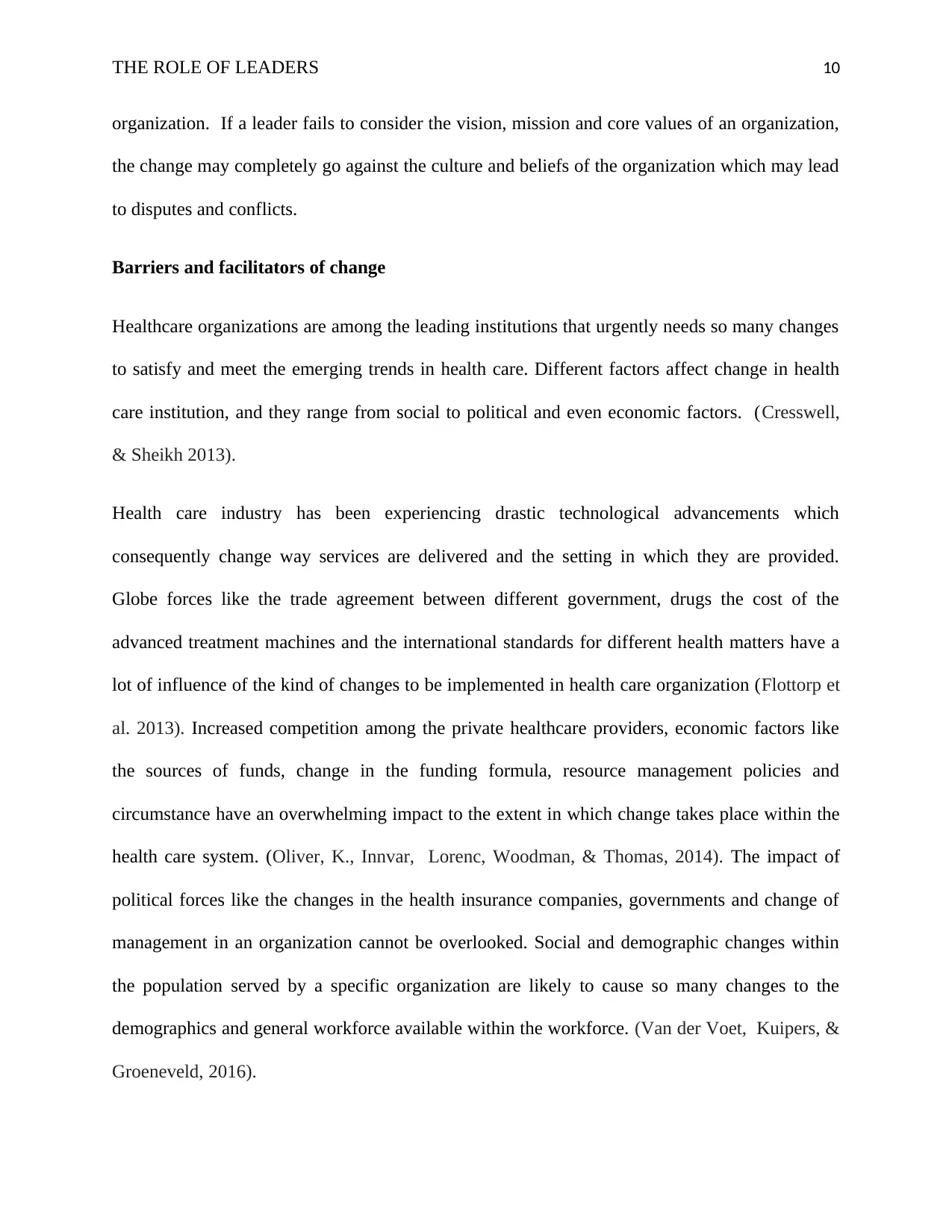
THE ROLE OF LEADERS 10
organization. If a leader fails to consider the vision, mission and core values of an organization,
the change may completely go against the culture and beliefs of the organization which may lead
to disputes and conflicts.
Barriers and facilitators of change
Healthcare organizations are among the leading institutions that urgently needs so many changes
to satisfy and meet the emerging trends in health care. Different factors affect change in health
care institution, and they range from social to political and even economic factors. (Cresswell,
& Sheikh 2013).
Health care industry has been experiencing drastic technological advancements which
consequently change way services are delivered and the setting in which they are provided.
Globe forces like the trade agreement between different government, drugs the cost of the
advanced treatment machines and the international standards for different health matters have a
lot of influence of the kind of changes to be implemented in health care organization (Flottorp et
al. 2013). Increased competition among the private healthcare providers, economic factors like
the sources of funds, change in the funding formula, resource management policies and
circumstance have an overwhelming impact to the extent in which change takes place within the
health care system. (Oliver, K., Innvar, Lorenc, Woodman, & Thomas, 2014). The impact of
political forces like the changes in the health insurance companies, governments and change of
management in an organization cannot be overlooked. Social and demographic changes within
the population served by a specific organization are likely to cause so many changes to the
demographics and general workforce available within the workforce. (Van der Voet, Kuipers, &
Groeneveld, 2016).
organization. If a leader fails to consider the vision, mission and core values of an organization,
the change may completely go against the culture and beliefs of the organization which may lead
to disputes and conflicts.
Barriers and facilitators of change
Healthcare organizations are among the leading institutions that urgently needs so many changes
to satisfy and meet the emerging trends in health care. Different factors affect change in health
care institution, and they range from social to political and even economic factors. (Cresswell,
& Sheikh 2013).
Health care industry has been experiencing drastic technological advancements which
consequently change way services are delivered and the setting in which they are provided.
Globe forces like the trade agreement between different government, drugs the cost of the
advanced treatment machines and the international standards for different health matters have a
lot of influence of the kind of changes to be implemented in health care organization (Flottorp et
al. 2013). Increased competition among the private healthcare providers, economic factors like
the sources of funds, change in the funding formula, resource management policies and
circumstance have an overwhelming impact to the extent in which change takes place within the
health care system. (Oliver, K., Innvar, Lorenc, Woodman, & Thomas, 2014). The impact of
political forces like the changes in the health insurance companies, governments and change of
management in an organization cannot be overlooked. Social and demographic changes within
the population served by a specific organization are likely to cause so many changes to the
demographics and general workforce available within the workforce. (Van der Voet, Kuipers, &
Groeneveld, 2016).
Paraphrase This Document
Need a fresh take? Get an instant paraphrase of this document with our AI Paraphraser
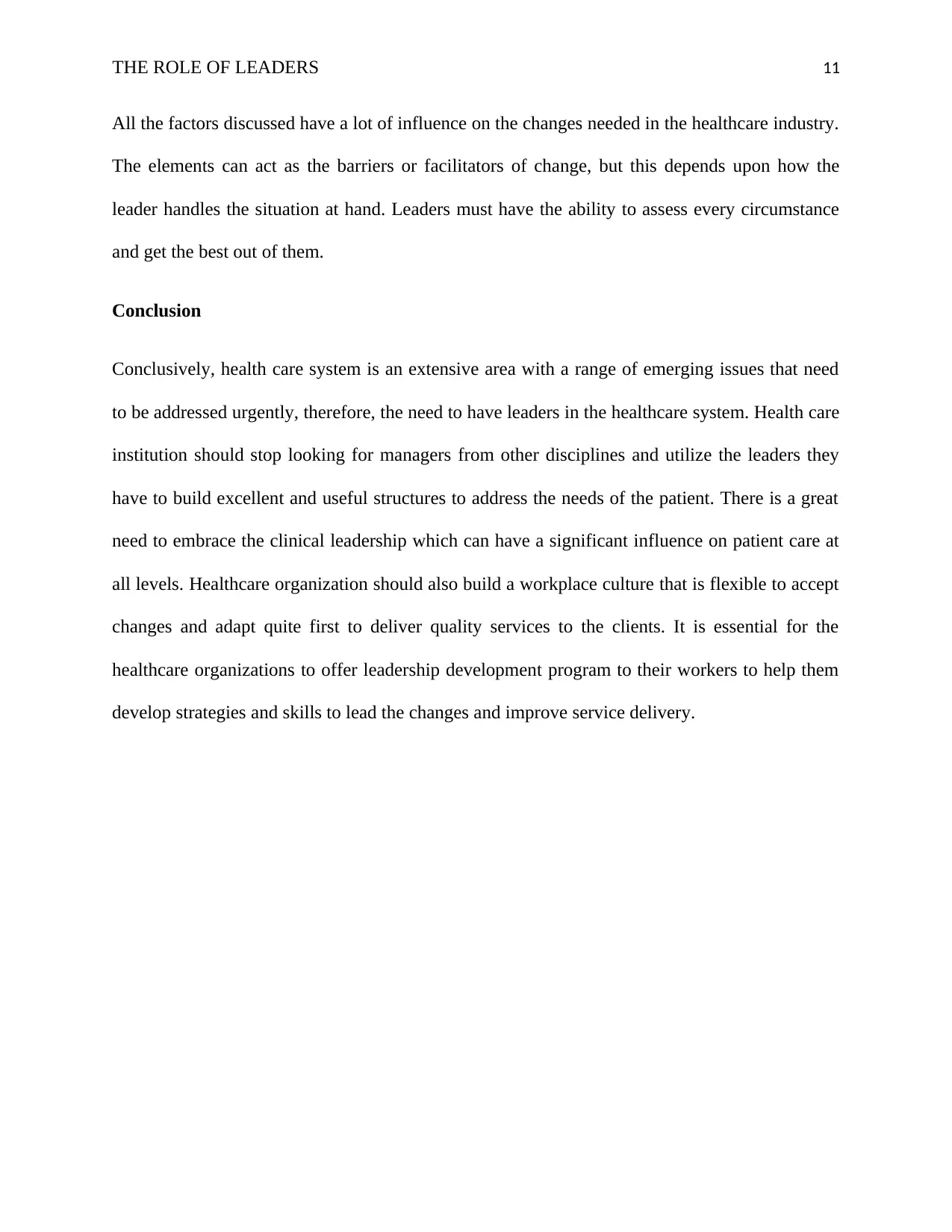
THE ROLE OF LEADERS 11
All the factors discussed have a lot of influence on the changes needed in the healthcare industry.
The elements can act as the barriers or facilitators of change, but this depends upon how the
leader handles the situation at hand. Leaders must have the ability to assess every circumstance
and get the best out of them.
Conclusion
Conclusively, health care system is an extensive area with a range of emerging issues that need
to be addressed urgently, therefore, the need to have leaders in the healthcare system. Health care
institution should stop looking for managers from other disciplines and utilize the leaders they
have to build excellent and useful structures to address the needs of the patient. There is a great
need to embrace the clinical leadership which can have a significant influence on patient care at
all levels. Healthcare organization should also build a workplace culture that is flexible to accept
changes and adapt quite first to deliver quality services to the clients. It is essential for the
healthcare organizations to offer leadership development program to their workers to help them
develop strategies and skills to lead the changes and improve service delivery.
All the factors discussed have a lot of influence on the changes needed in the healthcare industry.
The elements can act as the barriers or facilitators of change, but this depends upon how the
leader handles the situation at hand. Leaders must have the ability to assess every circumstance
and get the best out of them.
Conclusion
Conclusively, health care system is an extensive area with a range of emerging issues that need
to be addressed urgently, therefore, the need to have leaders in the healthcare system. Health care
institution should stop looking for managers from other disciplines and utilize the leaders they
have to build excellent and useful structures to address the needs of the patient. There is a great
need to embrace the clinical leadership which can have a significant influence on patient care at
all levels. Healthcare organization should also build a workplace culture that is flexible to accept
changes and adapt quite first to deliver quality services to the clients. It is essential for the
healthcare organizations to offer leadership development program to their workers to help them
develop strategies and skills to lead the changes and improve service delivery.
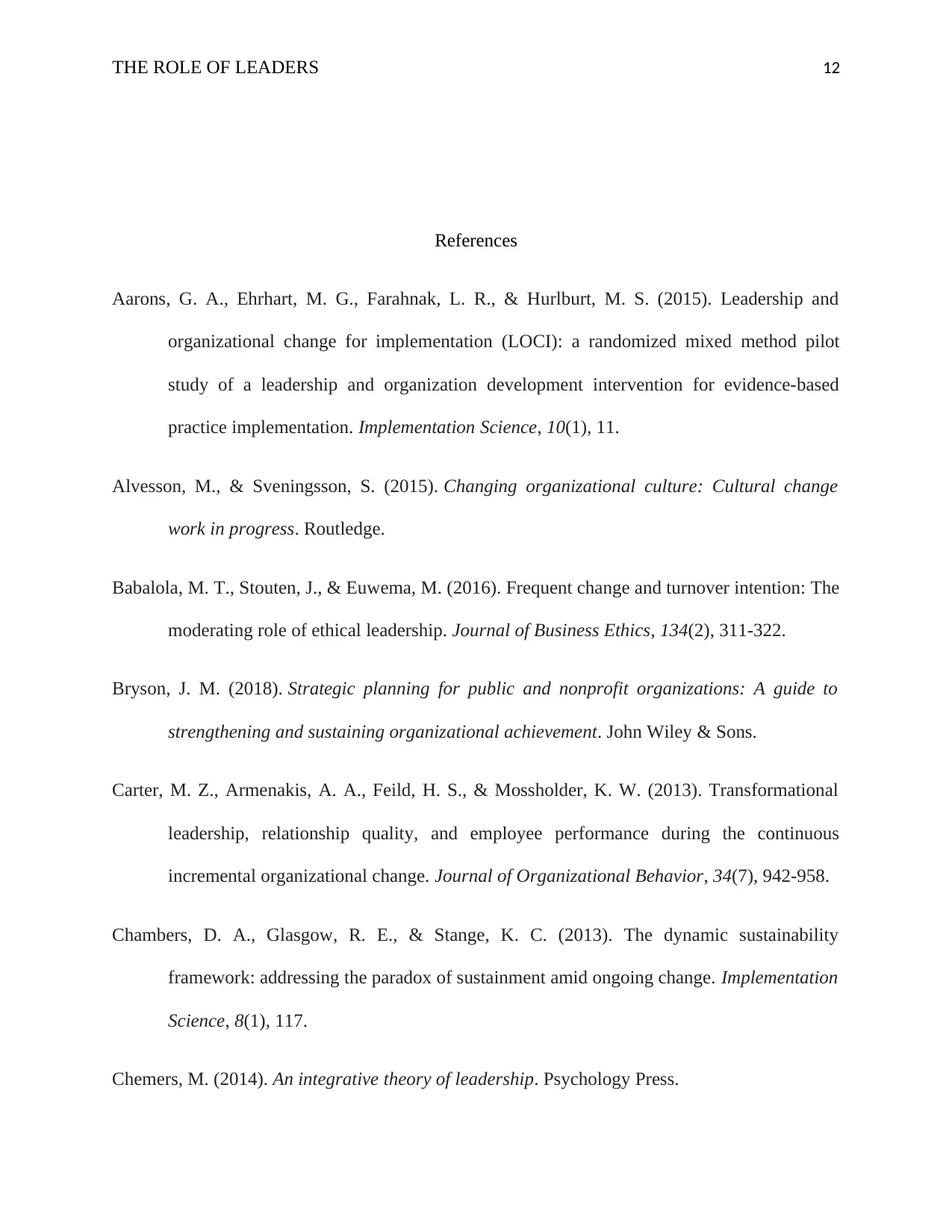
THE ROLE OF LEADERS 12
References
Aarons, G. A., Ehrhart, M. G., Farahnak, L. R., & Hurlburt, M. S. (2015). Leadership and
organizational change for implementation (LOCI): a randomized mixed method pilot
study of a leadership and organization development intervention for evidence-based
practice implementation. Implementation Science, 10(1), 11.
Alvesson, M., & Sveningsson, S. (2015). Changing organizational culture: Cultural change
work in progress. Routledge.
Babalola, M. T., Stouten, J., & Euwema, M. (2016). Frequent change and turnover intention: The
moderating role of ethical leadership. Journal of Business Ethics, 134(2), 311-322.
Bryson, J. M. (2018). Strategic planning for public and nonprofit organizations: A guide to
strengthening and sustaining organizational achievement. John Wiley & Sons.
Carter, M. Z., Armenakis, A. A., Feild, H. S., & Mossholder, K. W. (2013). Transformational
leadership, relationship quality, and employee performance during the continuous
incremental organizational change. Journal of Organizational Behavior, 34(7), 942-958.
Chambers, D. A., Glasgow, R. E., & Stange, K. C. (2013). The dynamic sustainability
framework: addressing the paradox of sustainment amid ongoing change. Implementation
Science, 8(1), 117.
Chemers, M. (2014). An integrative theory of leadership. Psychology Press.
References
Aarons, G. A., Ehrhart, M. G., Farahnak, L. R., & Hurlburt, M. S. (2015). Leadership and
organizational change for implementation (LOCI): a randomized mixed method pilot
study of a leadership and organization development intervention for evidence-based
practice implementation. Implementation Science, 10(1), 11.
Alvesson, M., & Sveningsson, S. (2015). Changing organizational culture: Cultural change
work in progress. Routledge.
Babalola, M. T., Stouten, J., & Euwema, M. (2016). Frequent change and turnover intention: The
moderating role of ethical leadership. Journal of Business Ethics, 134(2), 311-322.
Bryson, J. M. (2018). Strategic planning for public and nonprofit organizations: A guide to
strengthening and sustaining organizational achievement. John Wiley & Sons.
Carter, M. Z., Armenakis, A. A., Feild, H. S., & Mossholder, K. W. (2013). Transformational
leadership, relationship quality, and employee performance during the continuous
incremental organizational change. Journal of Organizational Behavior, 34(7), 942-958.
Chambers, D. A., Glasgow, R. E., & Stange, K. C. (2013). The dynamic sustainability
framework: addressing the paradox of sustainment amid ongoing change. Implementation
Science, 8(1), 117.
Chemers, M. (2014). An integrative theory of leadership. Psychology Press.
⊘ This is a preview!⊘
Do you want full access?
Subscribe today to unlock all pages.

Trusted by 1+ million students worldwide
1 out of 14
Related Documents
Your All-in-One AI-Powered Toolkit for Academic Success.
+13062052269
info@desklib.com
Available 24*7 on WhatsApp / Email
![[object Object]](/_next/static/media/star-bottom.7253800d.svg)
Unlock your academic potential
Copyright © 2020–2025 A2Z Services. All Rights Reserved. Developed and managed by ZUCOL.




